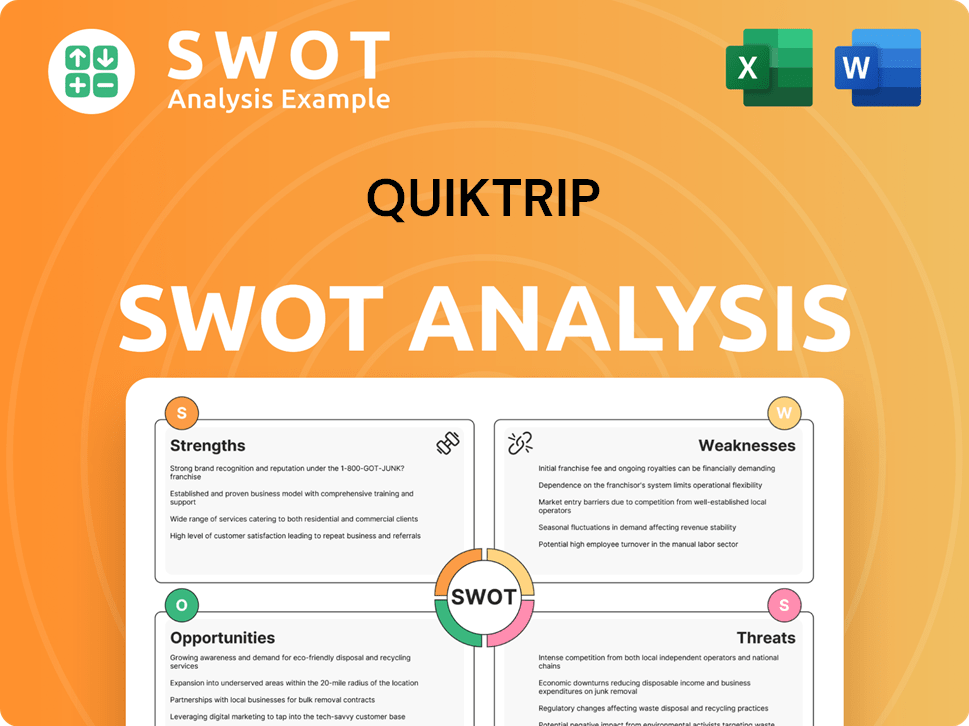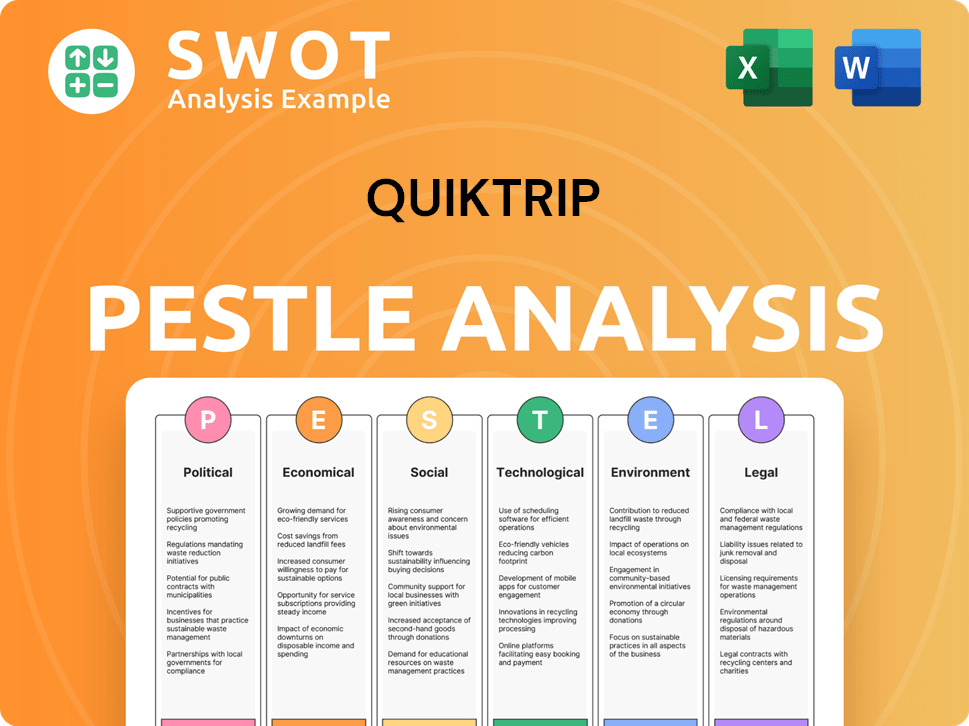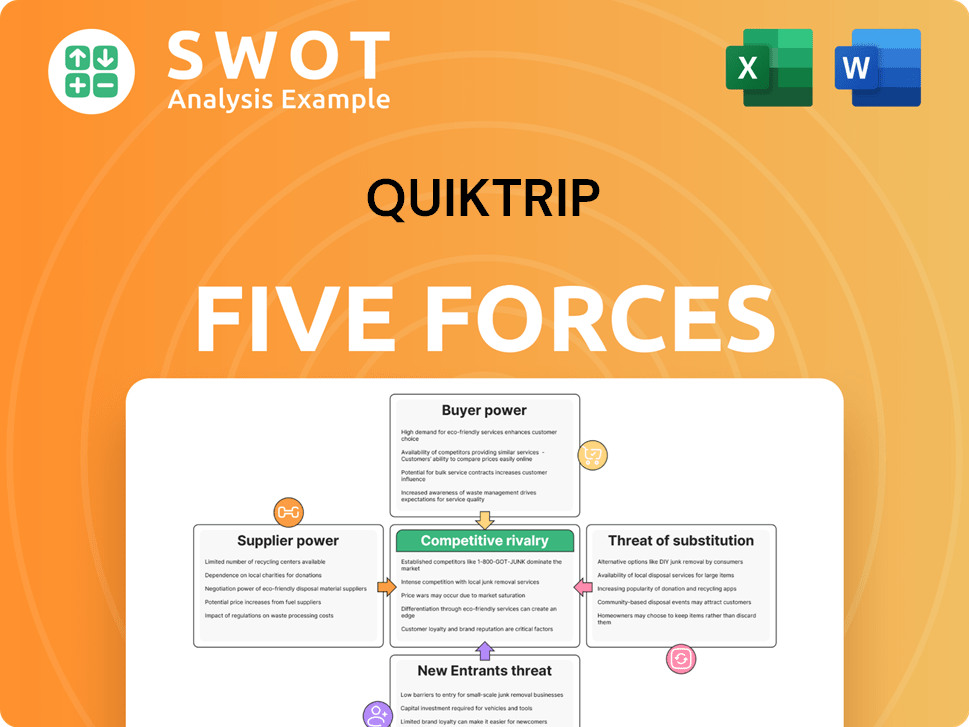QuikTrip Bundle
How Does QuikTrip Thrive in a Cutthroat Market?
In the ever-changing convenience store industry, understanding the QuikTrip SWOT Analysis is crucial. Founded in 1958, QuikTrip has grown from a single store to a major regional player. This growth highlights the company's ability to adapt and compete effectively in a dynamic environment.

This exploration of the QuikTrip competitive landscape will analyze its key competitors and market position. We'll examine the company's strategies and how it differentiates itself within the convenience store industry. Furthermore, a detailed QuikTrip market analysis will reveal the factors contributing to its sustained success and future outlook within the retail fuel market.
Where Does QuikTrip’ Stand in the Current Market?
QuikTrip (QT) holds a robust market position within the convenience store and gasoline retail sectors, particularly in the regions where it operates. While specific market share figures for privately held companies are not publicly available, industry analysts consistently place QT among the top convenience store chains, based on sales per store and overall customer satisfaction. The company's primary focus is on two main product lines: gasoline and in-store merchandise, which includes a wide variety of food, drinks, and snacks, with a notable emphasis on its fresh food offerings, such as QT Kitchen items.
Its geographic presence is concentrated in the Southern, Midwestern, and Southeastern United States, serving a broad customer segment from daily commuters to travelers seeking quick and convenient access to fuel and refreshments. QT has strategically positioned itself by investing heavily in its in-store food service, moving beyond traditional convenience store fare to compete more directly with fast-casual restaurants. This diversification of offerings, coupled with a consistent focus on store cleanliness and customer service, has solidified its premium market position within the convenience store segment.
Compared to industry averages, QT is known for its strong financial health, with high sales volumes per store and a reputation for efficient operations. The company holds a particularly strong position in metropolitan areas within states like Oklahoma, Kansas, Missouri, Iowa, Nebraska, Arizona, Georgia, Illinois, North Carolina, South Carolina, and Texas. Understanding the QuikTrip competitive landscape is crucial for anyone analyzing the convenience store industry.
QT's core operations revolve around two primary segments: fuel sales and in-store merchandise. The company operates a network of stores that offer gasoline, diesel, and alternative fuels, along with a wide array of convenience items. These include snacks, beverages, prepared foods, and other essentials. The operational efficiency and customer service are key differentiators.
QT's value proposition centers on providing a convenient, high-quality experience for its customers. This includes clean, well-maintained stores, friendly service, and a diverse selection of products, including fresh food options. The company also focuses on competitive pricing for fuel and merchandise, aiming to attract and retain customers through value and convenience.
QT's market focus is primarily on the Southern, Midwestern, and Southeastern United States. This geographic concentration allows the company to optimize its supply chain, marketing efforts, and customer service strategies. QT targets a broad customer base, including commuters, travelers, and local residents seeking convenient access to fuel, food, and other necessities.
QT's competitive advantages include its strong brand reputation, efficient operations, and focus on customer service. The company's investment in fresh food offerings and store cleanliness also sets it apart. Furthermore, QT's strategic store locations and efficient supply chain management contribute to its ability to offer competitive pricing and maintain high sales volumes.
QT's market position is reinforced by its strong financial performance and customer satisfaction. The company consistently ranks high in customer surveys, reflecting its commitment to quality and service. Analyzing the QuikTrip market analysis reveals its strategic focus on operational efficiency and customer-centric strategies.
- QT's focus on fresh food offerings allows it to compete with fast-casual restaurants, differentiating it from other convenience stores.
- QT's expansion strategy involves strategic store locations, focusing on high-traffic areas to maximize customer access.
- The company's emphasis on store cleanliness and customer service contributes to its premium market position.
- QT's strong financial health, characterized by high sales volumes per store, supports its ability to invest in improvements.
QuikTrip SWOT Analysis
- Complete SWOT Breakdown
- Fully Customizable
- Editable in Excel & Word
- Professional Formatting
- Investor-Ready Format

Who Are the Main Competitors Challenging QuikTrip?
Understanding the Marketing Strategy of QuikTrip requires a close look at its competitive environment. The QuikTrip competitive landscape is shaped by a diverse set of players, from large convenience store chains to supermarkets and fast-food restaurants. A thorough QuikTrip market analysis reveals the strategies these competitors employ and how they impact the company's position in the convenience store industry.
The QuikTrip competitors operate within a dynamic retail fuel market, where factors like pricing, location, and customer experience are crucial. The competitive intensity is heightened by mergers and acquisitions, and the emergence of new technologies and consumer preferences. Analyzing these elements is key to understanding the challenges and opportunities QuikTrip faces.
Direct competitors in the gas station competition include major convenience store chains. 7-Eleven, with its extensive global presence, offers a wide array of products and services. Circle K, known for competitive fuel pricing, is another significant player. Wawa, with its strong focus on fresh food, poses a direct challenge to QuikTrip's food offerings. Casey's General Stores, with its pizza program, competes particularly in smaller communities.
7-Eleven is a major player in the convenience store industry. It operates globally, with a vast network of stores offering a wide range of products and services.
Circle K is known for its competitive fuel pricing and a growing private-label product line. It has a significant presence in the U.S. and internationally.
Wawa is known for its fresh food service, custom-built hoagies, and coffee program. It primarily operates in the Mid-Atlantic and Florida regions.
Casey's General Stores competes through its pizza program and grocery items. It has a strong presence in the Midwest, catering to smaller, rural communities.
Supermarkets like Kroger and Walmart leverage extensive grocery selections and loyalty programs to attract fuel customers. They are indirect competitors.
Fast-food restaurants compete for the same 'food-on-the-go' customer segment that QuikTrip targets. They offer quick meal options.
Indirect competitors also play a significant role. Supermarkets with gas stations, such as Kroger and Walmart, utilize their extensive grocery selections and loyalty programs to attract fuel customers. Fast-food restaurants and quick-service eateries compete for the same 'food-on-the-go' market. Online food delivery services and grocery delivery platforms are emerging as potential disruptors. The QuikTrip market share analysis 2024 should consider these factors.
Several factors influence the competitive landscape. These include pricing strategies, store locations, product offerings, and customer service. Understanding these elements is crucial for a comprehensive QuikTrip SWOT analysis.
- Pricing Strategy: Competitive fuel and product pricing are essential for attracting customers.
- Store Locations: Strategic locations, particularly in high-traffic areas, are crucial for visibility and accessibility.
- Product Offerings: A wide variety of products, including fuel, food, and convenience items, caters to diverse customer needs.
- Customer Service: Excellent customer service enhances the overall shopping experience and fosters loyalty.
QuikTrip PESTLE Analysis
- Covers All 6 PESTLE Categories
- No Research Needed – Save Hours of Work
- Built by Experts, Trusted by Consultants
- Instant Download, Ready to Use
- 100% Editable, Fully Customizable

What Gives QuikTrip a Competitive Edge Over Its Rivals?
The Revenue Streams & Business Model of QuikTrip are built upon several key competitive advantages that have solidified its position in the convenience store industry. These advantages include operational efficiency, a strong brand reputation, and a unique company culture. This combination allows it to compete effectively in the retail fuel market and against other convenience store chains.
QuikTrip's success is also significantly influenced by its strategic moves, such as expanding its food service offerings with the QuikTrip Kitchen concept. This initiative allows it to compete directly with fast-food restaurants, increasing customer loyalty and boosting in-store sales. The company's focus on customer service and employee satisfaction further enhances its competitive edge.
The company's competitive advantages are continuously refined through investments in technology and operational improvements. These include advanced inventory management systems and self-checkout options, contributing to its ability to maintain competitive pricing and consistent product availability. The company's brand equity, built over decades, is a key differentiator in the gas station competition.
QuikTrip's operational efficiency is a cornerstone of its competitive strategy. This includes streamlined supply chains and efficient store layouts. These factors contribute to lower operating costs and enhanced customer service.
The company has built a strong brand reputation over many years. This is based on delivering a consistently positive customer experience. This brand recognition is a significant asset in attracting and retaining customers.
QuikTrip fosters a unique company culture that emphasizes employee development and internal promotion. This culture results in lower employee turnover compared to industry averages. This contributes to consistent service quality.
Continuous innovation, such as the QuikTrip Kitchen, is crucial. This allows the company to differentiate itself from competitors. It also helps meet evolving customer demands.
QuikTrip's competitive advantages are rooted in operational excellence, brand equity, and a unique company culture. These elements work together to create a sustainable competitive edge in the convenience store industry. These advantages contribute to QuikTrip's success in the retail fuel market.
- Operational Efficiency: Streamlined operations and supply chain management.
- Brand Reputation: Consistent customer service and quality.
- Employee Satisfaction: Low turnover and a motivated workforce.
- Food Service: Innovative offerings that drive in-store sales.
QuikTrip Business Model Canvas
- Complete 9-Block Business Model Canvas
- Effortlessly Communicate Your Business Strategy
- Investor-Ready BMC Format
- 100% Editable and Customizable
- Clear and Structured Layout

What Industry Trends Are Reshaping QuikTrip’s Competitive Landscape?
The convenience store and gasoline retail sector, where the company operates, is undergoing significant shifts, impacting the QuikTrip competitive landscape. Technological advancements, evolving consumer preferences, and regulatory changes are reshaping the industry. Understanding these trends is crucial for assessing the company's future prospects and strategic positioning within the retail fuel market.
The industry faces challenges from the rise of electric vehicles and shifting consumer demands for healthier food options. However, these challenges also present opportunities for innovation and diversification. The company must adapt to maintain its market position and capitalize on emerging trends to ensure long-term sustainability and growth. A detailed QuikTrip market analysis is essential.
The convenience store industry is experiencing a surge in demand for fresh, high-quality food. Consumers are increasingly seeking quick and convenient meal options. Digital technologies, such as mobile ordering and loyalty programs, are becoming increasingly important for enhancing customer experience and operational efficiency. The QuikTrip competitive landscape is also influenced by the growing popularity of online food delivery services.
The increasing adoption of electric vehicles poses a significant challenge to the traditional gasoline retail model. Changing consumer preferences, including the demand for healthier food choices, require adaptation. Regulatory changes related to environmental standards and fuel efficiency can impact operational costs. The expansion of online food delivery services presents a challenge to in-store food sales.
There's an opportunity to capitalize on the growing demand for high-quality, fresh food by expanding its food offerings, such as the QuikTrip Kitchen. Integrating more digital technologies, like mobile ordering and loyalty programs, can improve customer engagement. Strategic partnerships with EV charging networks can mitigate the impact of declining gasoline sales. Expanding into new geographic markets offers significant growth potential. Further understanding of Target Market of QuikTrip can help.
The company's strategy will likely involve continued investment in its food program, exploring alternative fueling options, and leveraging technology. Focusing on operational efficiency and customer loyalty is crucial. The emphasis on in-store experience and food service will be maintained as it navigates the transition away from a solely gasoline-centric business. The company must adapt to stay competitive.
The QuikTrip competitive landscape necessitates a diversified retail model. The company's focus should be on its in-store experience and food service. Strategic partnerships and technological integration are key to success.
- Adaptation to EV adoption and alternative fueling solutions.
- Expansion of food offerings and enhancement of digital technologies.
- Strategic partnerships to mitigate risks and capitalize on opportunities.
- Continued focus on operational efficiency and customer loyalty.
QuikTrip Porter's Five Forces Analysis
- Covers All 5 Competitive Forces in Detail
- Structured for Consultants, Students, and Founders
- 100% Editable in Microsoft Word & Excel
- Instant Digital Download – Use Immediately
- Compatible with Mac & PC – Fully Unlocked

Related Blogs
- What are Mission Vision & Core Values of QuikTrip Company?
- What is Growth Strategy and Future Prospects of QuikTrip Company?
- How Does QuikTrip Company Work?
- What is Sales and Marketing Strategy of QuikTrip Company?
- What is Brief History of QuikTrip Company?
- Who Owns QuikTrip Company?
- What is Customer Demographics and Target Market of QuikTrip Company?
Disclaimer
All information, articles, and product details provided on this website are for general informational and educational purposes only. We do not claim any ownership over, nor do we intend to infringe upon, any trademarks, copyrights, logos, brand names, or other intellectual property mentioned or depicted on this site. Such intellectual property remains the property of its respective owners, and any references here are made solely for identification or informational purposes, without implying any affiliation, endorsement, or partnership.
We make no representations or warranties, express or implied, regarding the accuracy, completeness, or suitability of any content or products presented. Nothing on this website should be construed as legal, tax, investment, financial, medical, or other professional advice. In addition, no part of this site—including articles or product references—constitutes a solicitation, recommendation, endorsement, advertisement, or offer to buy or sell any securities, franchises, or other financial instruments, particularly in jurisdictions where such activity would be unlawful.
All content is of a general nature and may not address the specific circumstances of any individual or entity. It is not a substitute for professional advice or services. Any actions you take based on the information provided here are strictly at your own risk. You accept full responsibility for any decisions or outcomes arising from your use of this website and agree to release us from any liability in connection with your use of, or reliance upon, the content or products found herein.